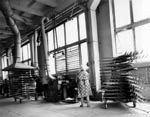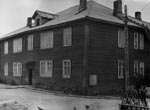 in Russian in Russian |
Suomeksi  |
The woodprocessing factory of Heliulia
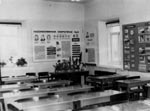
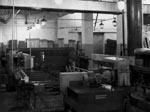
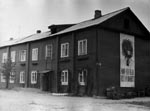 In 1966 the factory begins publlishing a newspaper "Mebelschik" ("The Furniture Maker"), which for four and a half years weekly brought to its readers the factory's news, told them about its famous workers, spoke about essential issues, discussed plans for the future. That same year several workers of the combine received Lenin's Order, The Labour Red Banner Order, The Honor Mark Order, and such medals as "For Labour Achievements" and "For Excellence In Labour".
In 1966 the factory begins publlishing a newspaper "Mebelschik" ("The Furniture Maker"), which for four and a half years weekly brought to its readers the factory's news, told them about its famous workers, spoke about essential issues, discussed plans for the future. That same year several workers of the combine received Lenin's Order, The Labour Red Banner Order, The Honor Mark Order, and such medals as "For Labour Achievements" and "For Excellence In Labour".

 and, indeed, after new objects were installed, production expanded and grew. During the Xth five-year period (1976-1980) the combine invested 4.3 million roubles in reconstruction. As a result of the reconstruction production of commodity products increased by 3 million roubles during that five-year period; given that the material supply for the combine was decreased by 44.7 cubic meters (almost by a third), ski production increased by 75.5 thousand pairs (16%). And, along with that, manufacture per worker increased by 949 roubles and the number of people involved in manual labour decreased by 79.
and, indeed, after new objects were installed, production expanded and grew. During the Xth five-year period (1976-1980) the combine invested 4.3 million roubles in reconstruction. As a result of the reconstruction production of commodity products increased by 3 million roubles during that five-year period; given that the material supply for the combine was decreased by 44.7 cubic meters (almost by a third), ski production increased by 75.5 thousand pairs (16%). And, along with that, manufacture per worker increased by 949 roubles and the number of people involved in manual labour decreased by 79.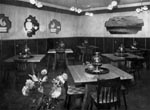 Ice hockey sticks, which the combine began producing iin 1977, deserve a special notice. Already a year and a half after the shop was started, their mass production hockey sticks receive the state "quality grade". 200 hockey sticks were produced were produced for the leaders of USSR and world hockey - the CSKA ice hockey team. The players' comments helped the combine workers, which developed newer versions of the product. In September, 1978 a USSR-wide conference regarding issues of producing a wider variety of hockey sticks and improving their quality took place in the Heliulia combine. Such an honor was presented to a small village, that can't be found on most maps. Thirty factories in the country were producing hockey sticks back then, but the conference was held at the woodprocessing factory, in Heliulia. And during that conference, at the exhibition-contest of the product, the representatives of only three factories were graded as class "A", including those produced in Heliulia. The tests proved these sticks to be the most durable, while remaining the lightest in weight.
Ice hockey sticks, which the combine began producing iin 1977, deserve a special notice. Already a year and a half after the shop was started, their mass production hockey sticks receive the state "quality grade". 200 hockey sticks were produced were produced for the leaders of USSR and world hockey - the CSKA ice hockey team. The players' comments helped the combine workers, which developed newer versions of the product. In September, 1978 a USSR-wide conference regarding issues of producing a wider variety of hockey sticks and improving their quality took place in the Heliulia combine. Such an honor was presented to a small village, that can't be found on most maps. Thirty factories in the country were producing hockey sticks back then, but the conference was held at the woodprocessing factory, in Heliulia. And during that conference, at the exhibition-contest of the product, the representatives of only three factories were graded as class "A", including those produced in Heliulia. The tests proved these sticks to be the most durable, while remaining the lightest in weight.

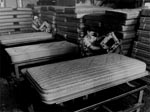 Generally, the activities on introduction of new equipment and technology, held at the combine, allowed to multiply the production volumes during the XIth five-year period (1981-1985) by 1.3, to increase labour productivity by 23.3%, to decrease the cost price by 6.41 copecks per rouble of products, to multiply the production of higher category goods by 7.7. Only because of reconstruction and technical upgrade of the shops the labour productivity at the combine grew by 25.4% during the five-year period. Economy was everywhere - one of the ways to use wasted valuable resources was the erection of a greenhouse of 600 m 2, the "green shop" of the combine, on the roof of the drying chambers in 1982. The heat, that used to go out into the atmosphere, was now used to grow tomatos, cucumbers, onion and other vegetable.
Generally, the activities on introduction of new equipment and technology, held at the combine, allowed to multiply the production volumes during the XIth five-year period (1981-1985) by 1.3, to increase labour productivity by 23.3%, to decrease the cost price by 6.41 copecks per rouble of products, to multiply the production of higher category goods by 7.7. Only because of reconstruction and technical upgrade of the shops the labour productivity at the combine grew by 25.4% during the five-year period. Economy was everywhere - one of the ways to use wasted valuable resources was the erection of a greenhouse of 600 m 2, the "green shop" of the combine, on the roof of the drying chambers in 1982. The heat, that used to go out into the atmosphere, was now used to grow tomatos, cucumbers, onion and other vegetable.
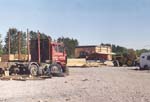 one of the suggested solutions to the combine's restoration was a so-called "Technological village" - a type of production organisation, where separate shops on the territory of the combine are rented by different firms, participating in the production process. In the beginning of the third millenium it was decided to choose this path, and at present production growth can be seen. Combine's revival also had a positive effect on employment of the population - commissioning of larger capacities created additional workplaces and vacancies and helped employ a part of the village's population. The main direction is still plastic skis production, performed by the "Sorsu" firm, and the current state of things allows us to look into the future with hope, even if our hope is moderate.
one of the suggested solutions to the combine's restoration was a so-called "Technological village" - a type of production organisation, where separate shops on the territory of the combine are rented by different firms, participating in the production process. In the beginning of the third millenium it was decided to choose this path, and at present production growth can be seen. Combine's revival also had a positive effect on employment of the population - commissioning of larger capacities created additional workplaces and vacancies and helped employ a part of the village's population. The main direction is still plastic skis production, performed by the "Sorsu" firm, and the current state of things allows us to look into the future with hope, even if our hope is moderate.
Materials of V.P. Sudakov's manuscript "Sortavala Furniture and Ski Combine" were used in the creation of this page.
